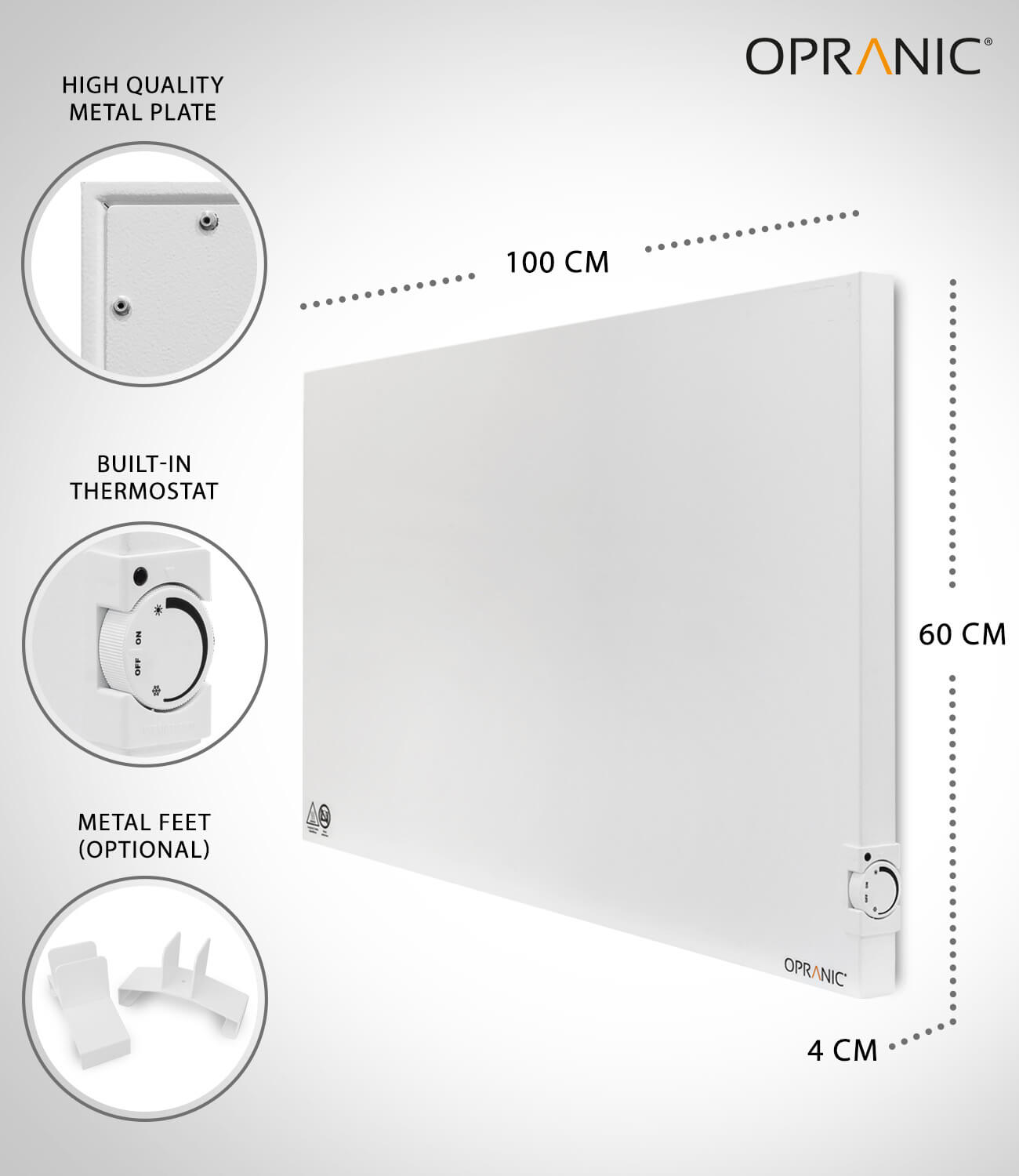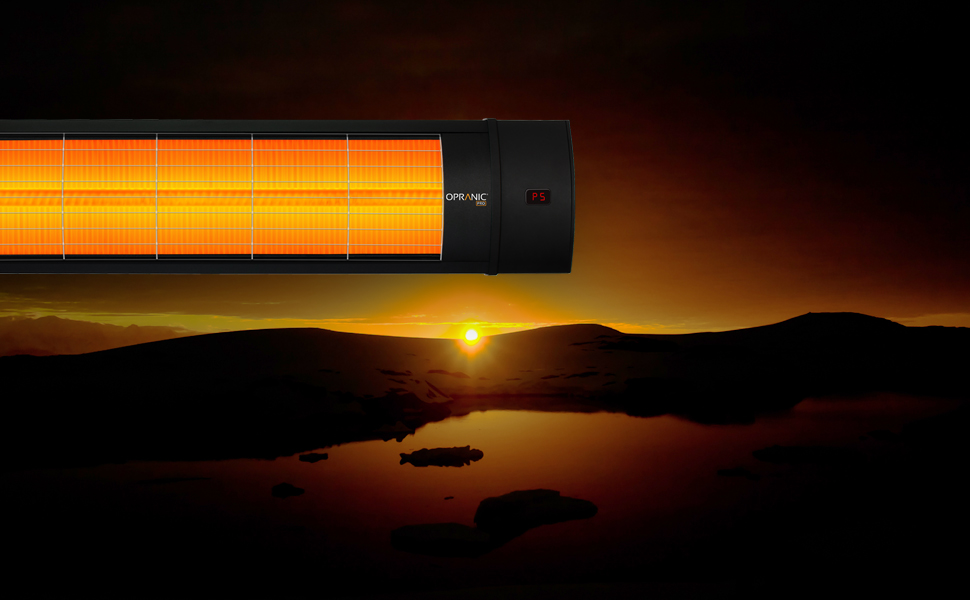Infrared heating is an innovative technology that is used in many applications. It is based on the use of infrared radiation, a form of electromagnetic radiation invisible to the human eye. This radiation is above the microwave spectrum and below visible light in the electromagnetic spectrum. In our introduction, we will explore the basics of this technology and understand how infrared heating is used in different areas.
Forms and function of infrared heaters
Infrared heaters come in a variety of forms, including radiators, wall panels and fan heaters. These devices generate infrared radiation, which emits heat and thus heats rooms efficiently. We will take a closer look at these heaters and explain their operation in more detail.
Advantages of infrared heaters
Introduction
The importance of infrared heating extends to various applications. From ceiling heating in the living room to wall heating in the bathroom, infrared heating plays a key role in modern heating technology.
It enables efficient and targeted heating of rooms. Understanding the fundamentals of this technology is critical to taking full advantage of its benefits.
Infrared heating technology has gained importance in recent years, especially in the field of energy-efficient space heating. It offers a sustainable way to heat rooms comfortably without having to put up with complex installations or high energy costs. Infrared heating is therefore a popular choice for many households and businesses.
The basics of infrared heating provide an important basis for optimal use.

Definition of infrared radiation
Properties and benefits of infrared radiation
Infrared radiation lies directly behind red light in the electromagnetic spectrum. Unlike visible light, which we can see, infrared is invisible to the human eye. This property makes them ideal for applications such as infrared radiant heaters, which radiate heat selectively without producing visible light. We will also discuss the difference between visible light and infrared radiation to capture the essence of this technology.
Infrared radiation extends over a wide range of the electromagnetic spectrum, being located after visible light. Unlike visible light, which we can perceive, infrared is invisible to the human eye. This makes it possible to detect heat and radiation that would otherwise go undetected. Infrared heating makes optimum use of this radiation to ensure efficient heat transfer.
The infrared spectrum briefly explained
Shortwave (also referred to as IR-A or Near Infrared) has wavelengths between 0.78 – 1.4μm.
Short-wave infrared emitters operate in the wavelength range from 780 nm to 1,400 nm and emit temperatures from 1,300°C to 2,600°C as well as a bright visible light. The radiators usually consist of quartz filled with halogen gas and a reflector to direct the heat in a specific direction.
Medium wave (also called IR-B) has wavelengths between 1.4 and 3.0μm.
Medium-wave infrared emitters operate in the wavelength range from 1,400 nm to 3,000 nm and emit temperatures from 500°C to 1,300°C. They produce a deeply dimmed red light. The radiators can be made of quartz with a reflector to direct the heat in a specific direction.
Long-wave infrared (also called IR-C or far-infrared) has wavelengths between 3.0 and 1,000 μm.
Long-wave infrared heaters operate in the wavelength range above 3,000 nm. Long-wavelength infrared elements emit much lower temperatures, usually between 100°C and 500°C, and no visible light.

The figure shows the relationship between wavelength and absorption of infrared radiation by water. Humans are made up of approximately 80% water. For comfortable heating, an infrared heater should therefore optimize its performance in the wavelengths where water is best absorbed.
How does infrared technology work?
Generation and distribution of heat
The heaters, such as radiant heaters and wall panels, generate infrared rays using electric heating elements. These rays are then emitted into the room. When they hit surfaces and objects, they are absorbed by the infrared rays. In the process, the surfaces begin to give off heat, much like our skin absorbs heat from the sun’s rays.
The emitted heat from the heated surfaces radiates evenly into the room, warming the surrounding air. Unlike conventional heaters, which heat the air and warm air rises, infrared heating distributes heat evenly throughout the room. This provides a cozy and comfortable room temperature, without unpleasant air movements. Infrared heating therefore offers an effective method of heating rooms.
The basics of infrared heating show why this method is so efficient.
Basics of generation and detection
Basic principles and efficiency
The basic principles of infrared radiation generation and detection are essential to understand the infrared heating system. Radiant heaters and wall panels play a central role in generating infrared rays, which are emitted into the room as heat. In contrast, thermostatic heaters use intelligent sensors to precisely monitor and regulate room temperature. These processes are largely responsible for the efficiency and performance of infrared heaters.
Infrared radiation is generated by special electric heating elements integrated in radiant heaters and wall panels. These heating elements convert electrical energy into heat and radiate it in the form of invisible infrared rays. These infrared rays strike surfaces and objects in the room and transfer their thermal energy. This leads to gradual heating of surfaces and ultimately the surrounding air. The result is extremely efficient and even heating of the entire room, making infrared heating a convincing choice for effective room heating.
The basics of infrared heating explain how this technology works.
Applications of infrared technology
Industrial applications and advantages
Infrared heaters are widely used in industry and are crucial for various production processes. For example, they are used in plastics processing to precisely melt plastics, in food processing for baking and drying processes, and in automotive manufacturing for rapid drying of vehicle parts. They are also used in metal processing for preheating metal parts and for drying and curing processes for coatings, paints and varnishes.
Infrared heaters provide an efficient and precise method of generating heat that meets the requirements of a wide variety of industrial production environments and optimizes the manufacturing process. They are also used in various other industries, from medicine, where they are used in therapy applications, to home use for comfortable space heating and energy-efficient solutions. The versatility of infrared heating makes it a valuable technology in many areas.
The basics of infrared heating are of central importance.

Advantages of infrared heating
Why is infrared heating used in many areas? The advantages are manifold. They include high energy efficiency, precise temperature control, fast heat release and low heat loss. Infrared heaters are also space-saving and environmentally friendly.
The use of infrared heating offers numerous advantages. They are energy efficient because they radiate heat selectively and thus reduce energy consumption. Precise temperature control ensures optimum comfort, while rapid heat release allows for quick heat-up. At the same time, they minimize heat losses, which further increases efficiency. Infrared heating is therefore an excellent choice for various heating purposes.
The basics of infrared heating make these advantages clear.
Future prospects

Innovations and future applications
Infrared heating technology is experiencing a period of continuous innovation, enabling promising future applications in a wide range of fields:
Industrial process optimization: Infrared heaters, such as advanced radiant heaters and heating panels, are playing an increasingly important role in industrial process optimization. For example, they could be used in semiconductor manufacturing to precisely control temperature during the manufacturing process to improve the quality of the chips produced.
Healthcare: In healthcare, infrared heaters, including thermostatic heaters, could play a critical role in heat therapy. They could help speed patient recovery and effectively relieve pain.
Agriculture: In agriculture, infrared heaters, such as ceiling heaters in greenhouses, open up the possibility of creating optimal growing conditions for plants. This is independent of the fluctuations in outdoor temperatures and can improve crop yields.
Energy-efficient buildings: The integration of infrared heating, such as wall panels with precise temperature control, into smart building systems will further increase the energy efficiency of residential and commercial buildings. These heaters intelligently adjust to the actual use and presence of people, resulting in significant energy savings.
These examples underscore the promising prospects for infrared heating technology, which will play an increasingly important role in a wide range of industries in the future. The fundamentals of infrared heating will always form the basis for these developments.
Summary
Final thoughts on infrared heating
We explored the basics of infrared heating, highlighted its applications in different areas and outlined its benefits. The fascinating world of infrared heating offers many possibilities to use energy efficiently and to heat rooms comfortably. We encourage you to further explore this technology and exploit its potential.
Infrared heating is a forward-looking technology with a wide range of applications and benefits. From efficient space heating to supporting industrial processes, it offers solutions for various needs. We have explored the basics of infrared heating, applications and benefits of this technology and hope you are inspired to explore its possibilities further.
-
V70-Series This product has multiple variants. The options may be chosen on the product page
-
Cover-serieThis product has multiple variants. The options may be chosen on the product page
Protective Cover for Thor
£39.00 -
Opranic-RemotesThis product has multiple variants. The options may be chosen on the product page
Opranic Remote Controls
£15.00 -
S70-Family This product has multiple variants. The options may be chosen on the product page
-
VEGA-SeriesThis product has multiple variants. The options may be chosen on the product page
OPRANIC I90 – VEGA Industrial Infraheater
Price range: £1 190.00 through £1 490.00 -
P7-SeriesThis product has multiple variants. The options may be chosen on the product page
OPRANIC P7 Glass Infrared Panel Heater 450W – 900W in White or Black
Price range: £429.00 through £649.00 -
Sale P6 Hybrid Series This product has multiple variants. The options may be chosen on the product page
-
Sale P5 Metal Series This product has multiple variants. The options may be chosen on the product page
























